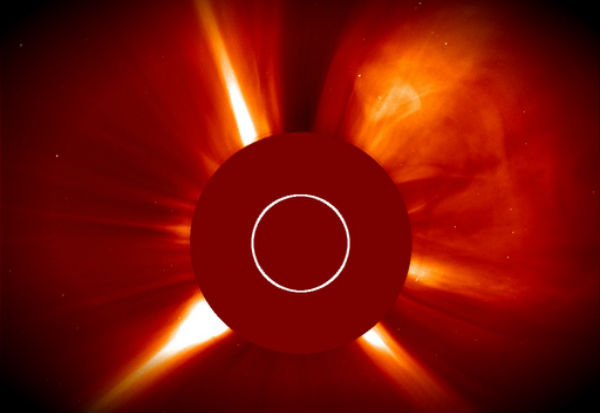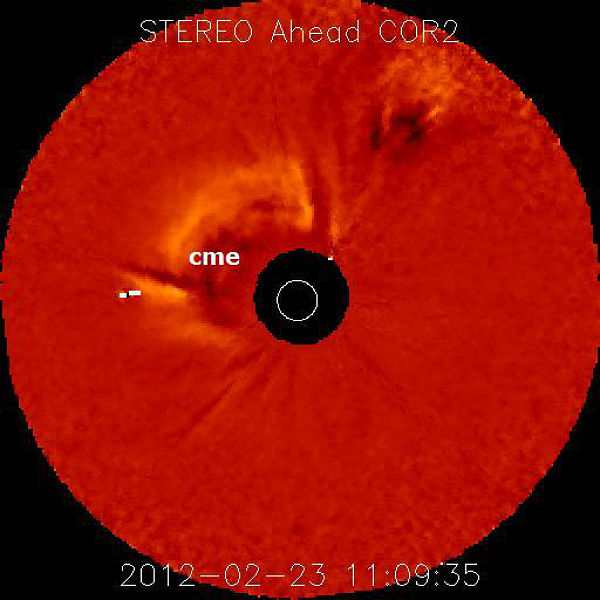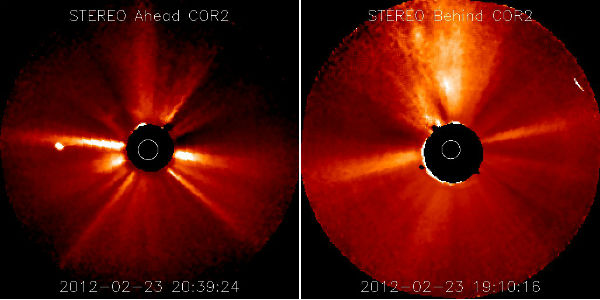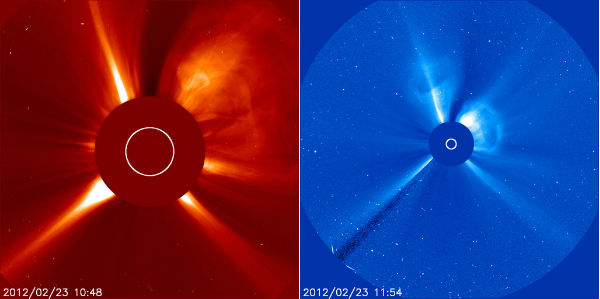Solar filament channel eruption and aurora forecast

A Coronal Mass Ejection (CME) is seen in the latest STEREO Ahead COR2 images on Thursday morning, and the source appears to be a filament channel eruption near region 1419 in the northwest quadrant. After a close look, the expanding cloud appears to be directed mostly to the west, however more data will be needed to determine if there will be an earthward component. (CME Forecast)
 (Today’s CME (Credit: STEREO/SolarHam)
(Today’s CME (Credit: STEREO/SolarHam)  Images of CME from STEREO Ahead and Behind (Source: STEREO)
Images of CME from STEREO Ahead and Behind (Source: STEREO) 


Sunspot 1422 remains the largest visible sunspot with chances for C-class flares. Old Sunspot 1410 is now rotating back into view on the northeast limb. It appears to be an alpha region and the chances for moderate solar flares will remain very low. A new region is rotating onto the visible disk. For now it appears to be a single stable spot.
CURRENT CONDITIONS
Solar wind
speed: 443.5 km/sec
density: 1.0 protons/cm3
The Radio Sun
10.7 cm flux: 104 sfu
Planetary K-index
Now: Kp= 1 quiet
24-hr max: Kp= 1 quiet
Interplanetary Mag. Field
Btotal: 5.6 nT
Bz: 2.8 nT south
Joint USAF/NOAA Report of Solar and Geophysical Activity (22 Feb 2012)
Solar activity was very low. There were two B-class flares during the last 24 hours. The largest of these was a B5 at 1937Z from Region 1422 (N15W38). Region 1422 has shown steady decay during the period. Solar activity is expected to be very low. There is a chance, however, for an isolated C-class flare. The geomagnetic field has been at quiet to unsettled levels. A weak shock was observed at the ACE spacecraft at 22/0120Z and was followed by a sudden impulse of 20 nT at 22/0223Z at the Boulder magnetometer. Somewhat later in the day a solar sector boundary crossing was observed (22/0815Z) and was followed by a marked increase in solar wind velocity, indicative of the onset of a high-speed stream from a coronal hole.
The geomagnetic field is expected to be quiet to unsettled with a chance for isolated active periods during the next 24 hours as effects from the high-speed stream persist. Predominantly quiet levels are expected for the second and third days (24-25 February).
AURORA
NOAA/SWPC forecasters estimate a 25% chance of polar geomagnetic storms today in response to a medium-speed (~450 km/s) solar wind stream, which is buffeting Earth’s magnetic field. Arctic sky watchers should be alert for auroras around polar circle. Stay tuned for new aurora display images.


..

Commenting rules and guidelines
We value the thoughts and opinions of our readers and welcome healthy discussions on our website. In order to maintain a respectful and positive community, we ask that all commenters follow these rules.